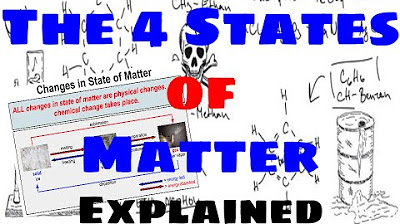Moment of Inertia Introduction and Rotational Kinetic Energy Derivation
Summary
TLDRIn this educational video, Mr. P and his students explore the concepts of kinetic energy, focusing on both translational and rotational types. They delve into the difference between the energy of motion for an object moving from one point to another (translational kinetic energy) and the energy associated with rotation (rotational kinetic energy). The moment of inertia, or 'rotational mass,' is introduced as a key factor in rotational motion, emphasizing its role in resisting angular acceleration. Through a hands-on example with eggs in an egg carton, the video illustrates how mass distribution affects rotational inertia and angular acceleration.
Takeaways
- 😀 Kinetic energy is the energy of motion, and it’s calculated as one-half mass times velocity squared.
- 😀 An object with no motion of its center of mass, like a rotating bike wheel, might appear to have zero kinetic energy, but this is misleading.
- 😀 The total kinetic energy of a rotating object is the sum of the kinetic energies of its individual pieces, not just the center of mass.
- 😀 The equation for rotational kinetic energy involves the moment of inertia and the angular velocity of the object.
- 😀 Tangential velocity is related to angular velocity by the equation: Tangential velocity = radius × angular velocity.
- 😀 Moment of inertia (I) is a measure of an object’s resistance to angular acceleration, similar to mass being a measure of resistance to linear acceleration.
- 😀 The moment of inertia is calculated by summing the mass of each piece of an object multiplied by the square of its distance from the axis of rotation.
- 😀 Rotational kinetic energy is defined as one-half times the moment of inertia times the square of the angular velocity.
- 😀 Translational kinetic energy is the kinetic energy associated with the motion of an object’s center of mass, whereas rotational kinetic energy is related to the object’s rotation.
- 😀 Moment of inertia is a key factor in determining how hard it is to change an object's rotational motion. Increasing the distance of mass from the axis of rotation increases the moment of inertia and makes it harder to rotate the object.
Q & A
What is the equation for kinetic energy?
-The equation for kinetic energy is Kinetic Energy = 1/2 * mass * velocity^2.
Why does the wheel in the example have zero kinetic energy when its center of mass is not moving?
-The wheel has zero kinetic energy in this case because the velocity of the center of mass is zero, meaning it does not move from one point to another, which is required for translational kinetic energy.
How is the kinetic energy of a rotating object different from that of an object with no rotation?
-The kinetic energy of a rotating object is determined by the rotational kinetic energy, which accounts for the motion of all small pieces making up the object, while an object with no rotation only has translational kinetic energy associated with the motion of its center of mass.
What is the total kinetic energy of the rotating object?
-The total kinetic energy of the rotating object, known as the rotational kinetic energy, is given by the equation: 1/2 * moment of inertia * angular velocity^2.
What is the difference between translational kinetic energy and rotational kinetic energy?
-Translational kinetic energy refers to the energy associated with the motion of an object’s center of mass, while rotational kinetic energy is the energy due to the rotation of the object around its axis.
What is the moment of inertia, and how does it relate to rotational kinetic energy?
-The moment of inertia is a measure of an object's resistance to angular acceleration. It is defined as the sum of the mass of each piece of an object times the square of the distance from the axis of rotation. It replaces the inertial mass in the rotational kinetic energy equation.
What is the connection between angular velocity (omega) and tangential velocity (v)?
-Tangential velocity (v) is related to angular velocity (omega) by the equation v = radius * omega, where the radius is the distance from the axis of rotation to the point of interest on the object.
What happens to the moment of inertia if the distance of an object’s mass from the axis of rotation is increased?
-If the distance of an object’s mass from the axis of rotation is increased, the moment of inertia increases. This makes it harder to rotate the object, as it resists angular acceleration more.
How does the mass distribution of an object affect its moment of inertia?
-The moment of inertia is significantly influenced by the distribution of mass relative to the axis of rotation. A greater distance from the axis results in a much larger effect on the moment of inertia, as the distance is squared in the equation.
What does it mean when the transcript refers to the moment of inertia as 'rotational mass'?
-The term 'rotational mass' refers to the moment of inertia because it describes an object's resistance to angular acceleration, similar to how mass describes an object’s resistance to linear acceleration.
Outlines

This section is available to paid users only. Please upgrade to access this part.
Upgrade NowMindmap

This section is available to paid users only. Please upgrade to access this part.
Upgrade NowKeywords

This section is available to paid users only. Please upgrade to access this part.
Upgrade NowHighlights

This section is available to paid users only. Please upgrade to access this part.
Upgrade NowTranscripts

This section is available to paid users only. Please upgrade to access this part.
Upgrade NowBrowse More Related Video

The Four States of Matter - Explained

Lab Equipment - Explained

3. Gr 11 Life Sciences - Population Ecology - Theory 3 Mark Recapture Method

4. Gr 11 Life Sciences - Population Ecology - Worksheet 1

PENJASKES KELAS X - SOFTBALL

Introduction to Culture [AP Human Geography Review Unit 3 Topic 1]

Menentukan Mr ( massa molekul relatif )
5.0 / 5 (0 votes)